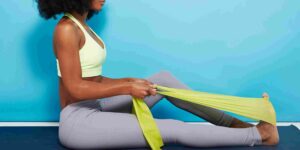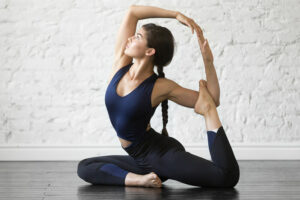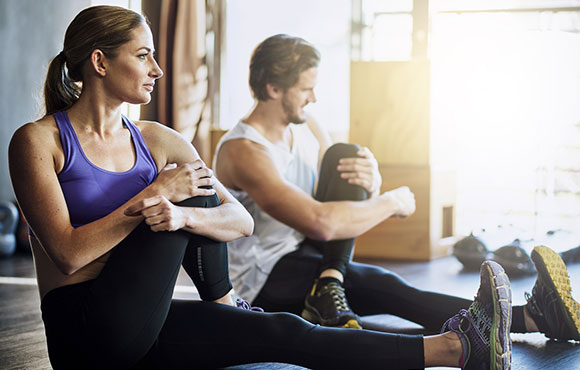Do you often feel tight and sore after a workout? This is completely normal, but it can also be frustrating. A good way to combat post-workout soreness is by doing some simple stretches. In this blog post, we will discuss the best stretches to do after your workout. These stretches will help loosen up your muscles and improve your flexibility. So, without further ado, let’s get started!
Contents
What Do Stretches Mean?
 Stretches are vital to performing after a workout. They help improve the range of motion, prevent injuries and promote muscular balance. It is described as “a movement or position in which a muscle is intentionally lengthened to its full range of motion.”
Stretches are vital to performing after a workout. They help improve the range of motion, prevent injuries and promote muscular balance. It is described as “a movement or position in which a muscle is intentionally lengthened to its full range of motion.”
There are many different types of stretches, but the most common are: static, ballistic, and PNF.
- Static stretching involves slowly moving your body into a position and holding it there for 15-30 seconds. It is important to hold the stretch for at least 15 seconds in order to fully lengthen the muscle.
- Ballistic stretching uses momentum to force your body into a position and then release. This type of stretching is not recommended because it can lead to injuries.
- PNF stretching is a combination of static and ballistic stretching. PNF stands
So these are some of the most important stretches which help in improving the range of motion and should be performed after a workout. Let’s further discuss some examples of stretches after a workout for better understanding.
What Are Some Examples Of Stretches After Workout?
There are a number of different stretches that can be beneficial after a workout. It is important to focus on stretching the muscles that were used during the workout. For example, if you went for a run, you would want to focus on stretches that target the muscles in your legs. A few examples of stretches that can be done after a workout include:
Cobra Stretch
It is important to do a Cobra Stretch after a workout because it helps to open up the chest and improve posture. To do this stretch, lie on your stomach with your palms flat on the ground next to your shoulders. Slowly lift your head and chest off the ground, keeping your lower body on the ground. Hold this position for 30 seconds before slowly lowering back down to the ground.
Quad Stretch
The Quad Stretch is important because it helps to stretch the muscles in the front of the thigh. It is a type of static stretch, which means that you should hold the stretch for at least 30 seconds. This type of stretch after a workout is beneficial because it can help to improve your range of motion and flexibility.
How to do the Quad Stretch:
- Stand up tall and place your hand on a wall or chair for support.
- Bend your knee and bring your heel up towards your buttock.
- Grab your ankle with your hand and pull your heel closer to your buttock.
- Hold the stretch for at least 30 seconds.
- Repeat on the other side.
Hamstring Stretch
The Hamstring Stretch is important because it helps to stretch the muscles in the back of the thigh. It is a type of static stretch, which means that you should hold the stretch for at least 30 seconds.
To do the Hamstring Stretch:
- Lie on your back with both legs extended in front of you.
- Bend one leg and place the foot of that leg on the opposite thigh.
- Use your hands to pull the bent leg toward your chest until you feel a stretch in the back of the thigh.
- Hold the stretch for 30 seconds, then release and repeat with the other leg.
Calf Stretch
 This is a type of static stretch in which you position your body so that your calf muscles are stretched. You can do this stretch by placing your hands on a wall and putting one leg behind the other, keeping your back heel on the ground. Then, lean forward until you feel a stretch in your calves. Hold this position for 15-30 seconds and repeat with the other leg.
This is a type of static stretch in which you position your body so that your calf muscles are stretched. You can do this stretch by placing your hands on a wall and putting one leg behind the other, keeping your back heel on the ground. Then, lean forward until you feel a stretch in your calves. Hold this position for 15-30 seconds and repeat with the other leg.
This stretch is particularly effective after running or any other type of exercise that works the calf muscles. Because the calf muscles are used a lot during exercise, they tend to become tight. This stretch can help to loosen them up and prevent cramping or pain in the calves.
Cat-Cow Stretch
It is a good idea to do some light stretching after your workout. This can help prevent injuries and aid in your recovery. The cat-cow stretch is a great way to loosen up your back and spine.
Begin on all fours with your hands and knees shoulder-width apart. As you inhale, arch your back and look up toward the ceiling. As you exhale, round your back and tuck your chin toward your chest. Repeat this stretch 10 times.
Downward Facing Dog
A downward-facing dog is a great way to stretch out your spine, shoulders, and hamstrings. It is also a very calming pose, which can be helpful after a strenuous workout. You can try this pose by starting on all fours, then lifting your hips and straightening your legs. Be sure to keep your hands and feet planted firmly on the ground, and your back nice and straight. For example, you might want to try a sun salutation after your workout.
Child’s Pose
It is no secret that working out can often lead to sore muscles the next day. To help alleviate some of that pain, start by stretching in Child’s Pose. This pose is also a great way to calm the mind and body after an intense workout.
To get into Child’s Pose, start on your hands and knees with your palms flat on the ground and your knees hip-width apart. As you exhale, slowly sit back on your heels and lower your forehead to the ground. You can also rest your arms alongside your body or extend them out in front of you. Hold this pose for at least 30 seconds before transitioning to the next one.
Pigeon Pose
 This type of stretch after a workout is great for opening up the hips, which can get tight from sitting all day or from running and other high-impact activities.
This type of stretch after a workout is great for opening up the hips, which can get tight from sitting all day or from running and other high-impact activities.
How to do it:
- Start in a downward dog position. Bring your right knee forward to your right wrist, then slide your left leg back.
- Lower your hips until you feel a stretch in your right hip. You can also place a blanket under your hips for extra support.
- Hold for 30 seconds, then switch sides and repeat.
Each of these stretches after the workout targets different muscle groups, so be sure to focus on the areas that you feel need the most attention. If you’re not sure how to do a particular stretch, there are plenty of resources available online or you can consult with a personal trainer.
Remember, it’s important to warm up before your workout and cool down afterward. These stretches are a great way to end your workout routine on a positive note and help reduce the risk of injury.
How Does Static Stretch Different From Dynamic Stretch?
It is important to know the difference between static and dynamic stretching so that you can properly warm up your muscles before a workout. Static stretching is when you stretch a muscle and hold it in that position for an extended period of time, usually about 30 seconds. Dynamic stretching is when you move your body or limbs through a range of motion repeatedly.
While static stretching is beneficial, it should not be done before a workout. This is because when you stretch a muscle and hold it in one position for an extended period of time, the muscle fibers actually become weaker. When you warm up with dynamic stretching, however, the muscle fibers are better able to handle the stress of exercise because they are being used repeatedly.
So, you should understand the difference between static and dynamic stretching before deciding which type of stretching to do after your workout. Because when you do dynamic stretching after your workout, the muscle fibers are already warm and can handle the stress of the stretch.
What Are The Benefits Of Stretching?
 There are many benefits to stretching after a workout. Some of the common ones are:
There are many benefits to stretching after a workout. Some of the common ones are:
- Increased flexibility and range of motion
- Decreased risk of injury
- Reduced muscle soreness
- Faster recovery from workouts
- Improved circulation
- Reduced stress levels
- Better posture
- Increased energy levels
- Improved mental clarity and focus
- Enhanced mind-body connection
More often you should be doing dynamic stretches, which are active movements that take your joints and muscles through their full range of motion. On the other hand, static stretches should generally be avoided immediately after a workout since they can actually decrease blood flow to the muscles and delay recovery.
These are just some of the benefits that stretching can provide. However, it’s important to note that not all stretches are created equal. So it becomes important to choose the right stretches to do after your workout, based on your individual needs.
What Are Some Safety Tips?
It is always important to take safety precautions when working out, and this includes stretching. Here are some safety tips to keep in mind when stretching:
- Warm up before stretching. A good warm-up will increase your heart rate and blood flow, which will help prepare your body for activity.
- Don’t bounce. Bouncing while you stretch can cause microscopic tears in the muscle.
- Hold each stretch for at least 20-30 seconds. This will give your muscles time to relax and lengthen.
- Repeat each stretch 2-3 times.
- Start by doing some light aerobic activity such as walking or jogging to get your heart rate up and blood flowing to your muscles.
- Finally make sure to stretch all major muscle groups, including the back, chest, shoulders, arms, legs, and buttocks.
It is also important to listen to your body and not push yourself too hard. If you feel pain while stretching, stop and try a different stretch. Because if you push through the pain, you could end up injuring yourself.
Therefore, these are some important safety tips to keep in mind when stretching. With these tips, you can help prevent injury and make sure you are getting the most out of your stretches.
Conclusion
To conclude stretches after a workout are an important part of keeping your body healthy and injury-free. It’s also important to find the right stretches for your body and to do them correctly. If you’re unsure about how to stretch properly, consult a certified trainer or physical therapist. And always listen to your body–if something feels wrong, stop doing the stretch and seek medical help if necessary!
Physical Therapy help patients recover from pain. If you’re experiencing Back pain, Shoulder pain, Knee pain, Neck pain, Elbow pain, Hip pain, or Arthritis pain, a physical therapist at MantraCare can help: Book a physiotherapy session.


